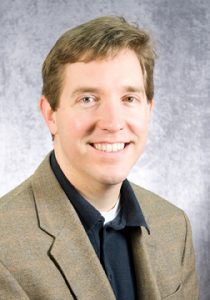 The successful pursuit of polymer research along two separate lines brought Associate Professor Michael Kessler to a simple yet unexpected confluence of ideas that raised a straightforward question: Why not combine them?
The successful pursuit of polymer research along two separate lines brought Associate Professor Michael Kessler to a simple yet unexpected confluence of ideas that raised a straightforward question: Why not combine them?
His proposal to do so has earned the materials science and engineering researcher a $400,000 National Science Foundation (NSF) CAREER award for a project titled “Multifunctional Biorenewable Polymers.” Funding for the work will begin in July.
In the area of biorenewable polymers, Kessler and chemistry department collaborator Distinguished Professor Richard Larock made substantial progress in demonstrating how polymers derived from vegetable oils were “excellent alternatives to petroleum-based resins for both environmental and economic reasons,” as Kessler wrote in his NSF proposal. In separate research on self-healing materials, Kessler had shown that polymers possessed “great potential” for solving problems of microcracking and hidden damage—key considerations for the lightweight composites used in aerospace structures.
“The proposal is to take these two separate ideas and merge them into a single material,” Kessler said, “and investigate if this self-healing functionality that we’ve demonstrated in synthetic materials can be applied to renewable materials.”
Kessler said the idea arose from an offhand comment made by a visiting seminar speaker, with whom Kessler had been discussing his two lines of research. During a subsequent brainstorming session with graduate students about potential proposal topics, Kessler simply noted the idea on a white board. It quickly rose to the top.
“I thought it was important to have some preliminary data to put into the proposal,” Kessler said, “and we had lots of preliminary data, references we had done, and papers we had written.”
Still, the idea of developing self-healing biorenewable polymers is yet to be demonstrated. The uniqueness is an opportunity and a challenge.
“There’s a handful of people doing work in self-healing polymers and a good number of people doing work in biorenewable polymers, but not together,” Kessler said. “I thought it was fairly straightforward to see how the two could merge, but I didn’t go into the lab and try to do it.”
Not yet. But when he does, the biggest leap will be to chemically bridge the gap between self-healing and vegetable oil-based polymers while introducing a new twist: using biorenewable healing agents; i.e., oils that can be encapsulated.
“All the work that we’ve done has been in an epoxy matrix,” Kessler said, noting that epoxy composites are commonly used in airplanes and sporting goods. So far, the self-healing functionality has been added to that base material. That approach needs to be resolved with the vegetable oil-based polymers developed by Kessler and Larock on a chemistry called ROMP (ring-opening metathesis polymerization).
The science behind bringing those two together involves using residual reactive sites in the matrix to react with the healing agent, and then to apply cationic polymerizations to the healing agent to induce compatibility with the ROMP system.
“We’re looking at some fundamental questions that have broader applications to the field of self-healing materials and biorenewable materials,” Kessler said. “Can we use the residual reactivity in the matrix to improve adhesion? By answering that kind of question, hopefully we can make a contribution to understanding in that realm.”
For the project as a whole, Kessler is guarded about long-term implications, preferring caution to excessive optimism. But he acknowledges the potential.
“The system that we are proposing is a low-cost alternative to some of the high-cost self-healing that’s been developed over the last several years,” he said. Most of the cost reduction would come from relying much less on a widely used but extremely expensive ruthenium catalyst.
“The applications for self-healing using that system are really limited to high-cost systems where you have to be able to repair in situ, such as aerospace applications,” Kessler said. Whereas the biorenewable materials with a cationic healing agent, by using much less of the ruthenium catalyst, make the process economical.
“I think there’s a real opportunity to extend self-healing technology to real-life applications where cost is a factor,” Kessler said. “I wouldn’t see the biorenewable materials being heavily used in aerospace composites, but composites are being used in a lot of other applications that are lower cost.”
Those other applications may have some real benefits in the realm of sustainability, something that motivates Kessler to pursue the research. As he points out, most technologies are limited by the materials they use.
“From a societal point of view, sustainable systems are key as the population grows,” he said. “We’ve got to find other alternatives to petroleum, not just for fuel but for materials, too. Most of the materials we use now that are plastics are derived from petroleum, so using biorenewable feedstock to make materials is a key driver in our quest for sustainability.”
“On the other side is multifunctional materials, with one of those functions being autonomic or self-healing. When you add multiple functions to a single material, you have big weight savings and materials that can push the envelope even more. In the automotive industry, lighter and stronger materials will go a long way toward improving fuel efficiency. Pursuing these kinds of questions about materials is really important to improving lives.”
